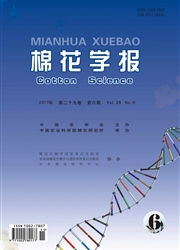

 中文摘要:
中文摘要:
研究低温条件下外源物质对棉花纤维比强度的影响。结果表明:在低温条件下,花后15d、30d外施C+N+BA均能提高棉花铃重和衣分,且以花后30d效果最好。花后30d外施BA可增加铃重,但效果远低于外施C+N+BA;花后15d外施BA对衣分的效果与C+N+BA大致相当。外施C+N、C+N+BA、BA均有利于优化棉纤维的螺旋角(φ)和取向分布角(Ф),提高纤维比强度,且花后15d、30d均以外施BA效果最佳。
 英文摘要:
英文摘要:
Under condition of condign temperature (22.7℃ ) and low temperature (19.9℃ ) during the cotton fiber thickening development period, with limpid water as a control, the effects of exogenous materials on fiber strength development was studied. This was done by daubing bolls setting on the l^st and 2^nd node in the 6^th to 9^th fruiting branches and their contrapuntal leaves at 15 days past anthesis (DPA) and 30 DPA with the mixture of 6% sucrose and 0.6% glutamine (C+N), the mixture of 6% sucrose, 0.6% glutamine and 2 μg . g%-1 6-BA (C+N+BA), and 2 μg . g^-1 6-BA, respectively. Results showed that, in low temperature conditions, exogenous mixtures could increase boll weight, lint percentage and fiber strength to different levels. Boll weight and lint percentage were enhanced when the bolls were treated with the mixture of 6% sucrose, 0.6% glutamine and2μg . g^-1 6-BA at 15DPA or 30DPA, respectively, and data showed the exogenous materials worked better on increasing boll weight when the treatment was performed on 30DPA. When referred to the treatment with 6-BA specifically, we found its effect on increasing boll weight was much lower than C+N+BA when it was used on 30DPA. Its effect on enhancing lint percentage was much higher than C-kN+BA when it was used in 15DPA. In the low temperature, all of the three exogenous mixtures could increase the cellulose content, consequently they could optimize the spiral angle (φ) and orientation angle(ψ) and these resulted in much higher fiber strength. BA could not obviously increase the cellulose deposition rate, but it could work on optimizing the spiral angle (φ) and orientation angle (ψ) and finally, the fiber strength treated with BA was the highest. The other mixtures each worked differently with the different application times. Though the increase of cellulose content of the bolls treated with C+N+BA was not lower than that of the bolls treated with BA. The effect on optimizing the spiral angle or orientation
 同期刊论文项目
同期刊论文项目
 同项目期刊论文
同项目期刊论文
 The rate of cellulose increase is highly related to cotton fibre strength and is significantly deter
The rate of cellulose increase is highly related to cotton fibre strength and is significantly deter Genotypic differences in some physiological characteristics during cotton fiber thickening and its i
Genotypic differences in some physiological characteristics during cotton fiber thickening and its i 期刊信息
期刊信息
